
Chaparral is a shrubland plant community found primarily in California, in southern Oregon and in the northern portion of the Baja California Peninsula in Mexico. It is shaped by a Mediterranean climate and infrequent, high-intensity crown fires.
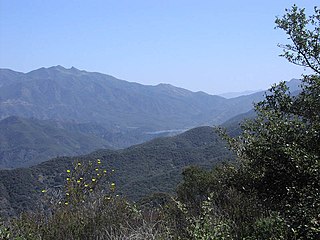
The California chaparral and woodlands is a terrestrial ecoregion of southwestern Oregon, northern, central, and southern California and northwestern Baja California (Mexico), located on the west coast of North America. It is an ecoregion of the Mediterranean forests, woodlands, and scrub biome, and part of the Nearctic realm.

The ecology of California can be understood by dividing the state into a number of ecoregions, which contain distinct ecological communities of plants and animals in a contiguous region. The ecoregions of California can be grouped into four major groups: desert ecoregions, Mediterranean ecoregions, forested mountains, and coastal forests.

Trichostema lanceolatum, with the common names vinegarweed and camphor weed, is an annual flowering herb of the mint family native to western North America.
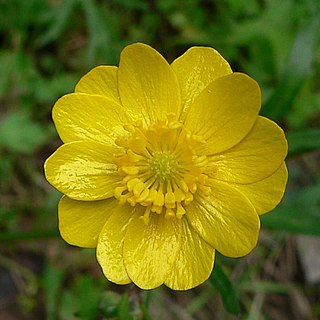
Ranunculus californicus, commonly known as the California buttercup, is a flowering plant of the buttercup family Ranunculaceae. It is a native of California, where it is common in many habitats, including chaparral and woodlands.

Baccharis pilularis, called coyote brush, chaparral broom, and bush baccharis, is a shrub in the family Asteraceae native to California, Oregon, Washington, and Baja California. There are reports of isolated populations in New Mexico, most likely introduced.

Proserpinus clarkiae, or Clark's sphinx, is a moth of the family Sphingidae. The species was first described by Jean Baptiste Boisduval in 1852. It is known from British Columbia and Washington south through California to Baja California, east to Idaho, Wyoming and Utah. The habitat consists of oak woodland and pine-oak woodland in foothills.

The subfamily Dasypodainae is a small subfamily of melittid bees, with more than 100 species in eight genera, found in Africa and the northern temperate zone, primarily in xeric habitats.

Rosa californica, the California wildrose, or California rose, is a species of rose native to the U.S. states of California and Oregon and the northern part of Baja California, Mexico. The plant is native to chaparral and woodlands and the Sierra Nevada foothills, and can survive drought, though it grows most abundantly in moist soils near water sources.
Clarkia affinis is a species of wildflower known as chaparral clarkia. It is endemic to California, where it grows mainly on chaparral slopes and woodlands in the Coast Ranges. This is a spindly plant producing erect stems exceeding half a meter in height and sparse narrow leaves. The flower is a bowl-shaped bloom with four pink or red petals each 5 to 15 millimeters long. The petals may have darker spots near the base and purple or red speckling.
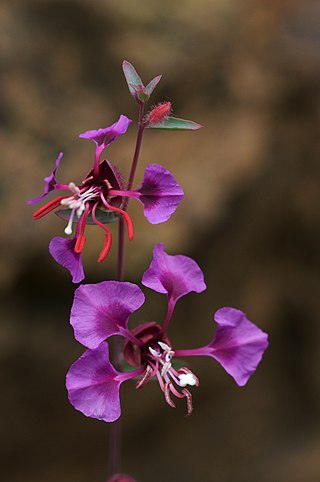
Clarkia unguiculata is a species of wildflower known by the common name elegant clarkia or mountain garland. This plant is endemic to California, where it is found in many woodland habitats. Specifically it is common on the forest floor of many oak woodlands, along with typical understory wildflowers that include Calochortus luteus, Cynoglossum grande and Delphinium variegatum. C. unguiculata presents a spindly, hairless, waxy stem not exceeding a meter in height and bears occasional narrow leaves. The showy flowers have hairy, fused sepals forming a cup beneath the corolla, and four petals each one to 2.5 centimeters long. The paddle-like petals are a shade of pink to reddish to purple and are slender and diamond-shaped or triangular. There are eight long stamens, the outer four of which have large red anthers. The stigma protrudes from the flower and can be quite large. Flowers of the genus Clarkia are primarily pollinated by specialist bees found in their native habitat "Clarkias independently developed self-pollination in 12 lineages."

Clarkia cylindrica is a species of flowering plant in the evening primrose family known by the common name speckled fairyfan, or speckled clarkia.

The Blue Oak Ranch Reserve, a unit of the University of California Natural Reserve System, is an ecological reserve and biological field station in Santa Clara County, California. It is located on 3,260 acres (13.2 km2) in the Diablo Range, northwest of Mount Hamilton, at 1,500 ft (460 m) elevation.

Clarkia arcuata is a species of flowering plant in the evening primrose family known by the common name glandular clarkia. It is endemic to California, where it grows in the chaparral and woodlands of the foothills of the Sierra Nevada and southern Cascade Range. It is an annual herb producing a slender, erect stem often exceeding half a meter in height. The leaves are narrow, usually linear or lance-shaped, and up to 6 centimeters long. The inflorescence bears a few flowers, which dangle when they are buds and grow erect as they open. The sepals stay fused as the petals open and emerge from one side. They are coated in glandular hairs. The petals are up to 3 centimeters long, pink-lavender in color, sometimes with a reddish blotch at the base. They form a bowl-shaped corolla. There are 8 stamens and a protruding, four-chambered ovary. The fruit is an elongated capsule which may reach 3.5 centimeters long.
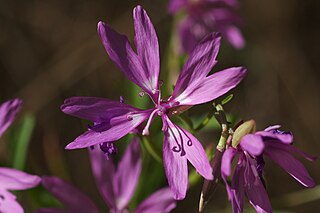
Clarkia biloba is a species of flowering plant in the evening primrose family known by the common name twolobe clarkia and two lobed clarkia.
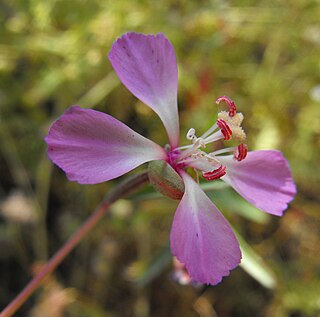
Clarkia delicata is a rare species of flowering plant in the evening primrose family known by the common names Campo clarkia and delicate clarkia. It is native to northern Baja California and adjacent San Diego County, California, where it grows in the woodland and chaparral of the Peninsular Ranges. This is an annual herb producing an erect stem just over half a meter in maximum height. The leaves are oval or widely lance-shaped, up to 4 centimeters long, and borne on very short petioles. The top of the stem is occupied by the inflorescence, in which the lower flowers open while the upper buds hang closed. The sepals remain fused as the flower blooms from one side. Each unlobed oval petal is about a centimeter long and pink to pinkish-lavender. There are 8 stamens, some with large orange anthers and some with smaller, paler anthers. There is also a protruding stigma with four large, fuzzy lobes.
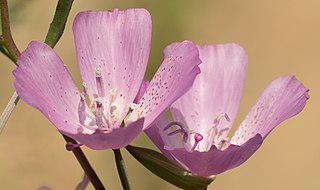
Clarkia dudleyana is a species of flowering plant in the evening primrose family known by the common name Dudley's clarkia. It is endemic to California, where it can be found in the mountains of the Transverse Ranges and the southern Sierra Nevada foothills. It grows in woodland, forest, and chaparral habitats under 1500 meters in elevation. This annual herb produces an erect stem sometimes exceeding half a meter in height. The leaves are lance-shaped, up to 7 centimeters long, and borne on short petioles. The top of the stem is occupied by the inflorescence, which has opening flowers below closed, hanging buds. As the flower blooms the pink to reddish-purple sepals remain fused, opening along one side only. The petals are up to 3 centimeters long, fan-shaped, pinkish lavender in color and sometimes flecked with red. There are 8 stamens, some of which have large lavender anthers and some that have smaller, paler anthers. The stigma protrudes farther than the stamens.

Clarkia epilobioides is a species of flowering plant in the evening primrose family known by the common name canyon clarkia. It is native to California, Arizona, and Baja California, where it grows in shaded habitat in woodland and chaparral. It is an annual herb producing a slender, erect stem sometimes exceeding half a meter in height. The leaves are narrowly to widely lance-shaped and less than 3 centimeters long. The top of the stem is occupied by the inflorescence. Each hanging bud has four red sepals which remain fused all together or in pairs as the petals emerge during blooming. The petals are one half to one centimeter long, oval in shape, solid white or cream in color, often fading pink as they age. There are eight protruding stamens and one stigma.
Clarkia tembloriensis is a rare species of flowering plant in the evening primrose family, known by the common name Temblor Range clarkia and belonging to the Onagraceae family.

The California carpenter bee, Xylocopa californica, is a species of carpenter bee in the order Hymenoptera, and it is native to western North America.


















